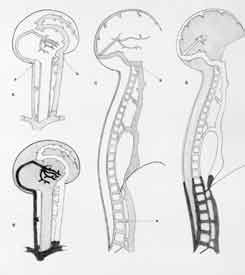|
Plate XIV.
Click image to enlarge
 |
|
Anatomical substratum necessary for the specific lesions' development
(Synoptic sketches by the author).
Fig. A, Anomalous structural predispositions towards unduly intense venous
regurgitations into veins of the brainstem and periventricular cerebral
veins:
a, narrow and strictly confined pathway of regurgitation along an internal
jugular vein not guarded by a competent venous valve;
b, opportunities for an abundant venting, i.e. fast and copious evacuation
from, in particular, other veins of the cranial cavity via the contralateral
internal jugular vein.
|
Fig. B, Pathway of injurious regurgitations into central cerebral veins (in
black):
leeway for volume-shifts inside the craniovertebral space, allowing for the
inner cerebral veins' expansion (in grey);
venous drainages providing for the compensatory venting of the
craniovertebral space by an intensified efflux from, above all, cerebral veins
(in white).
Fig. C, Requirements for an excessive intensification of regurgitations from
abdominal veins into the venous plexuses surrounding the lowest part of the
spinal dural sac:
a, unusual widening of the local pathways of venous regurgitation, such as
in particular the lower, i.e. lumbosacral, intervertebral veins;
b, opportunities for rapid and massive evacuations from upper spinal canal
and, above all, cranial cavity by an intensified outflow via especially the
internal jugular veins.
|
|
Fig. D, Spread of venous regurgitations from abdomen into lower spinal canal
(in black).
Leeway for subarachnoid fluid shifts, allowing for the expansion of spinal
epidural veins (in grey)
Venous drainages providing for the compensatory venting of the
craniovertebral space by voluminous high-speed evacuations of veins of upper
spinal canal and, above all, cranial cavity (in white).
|